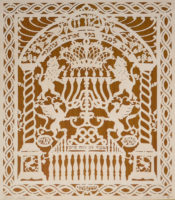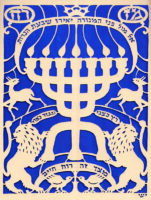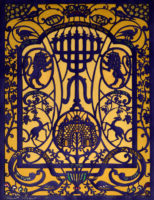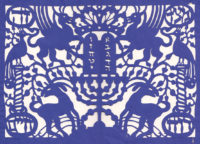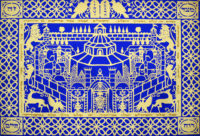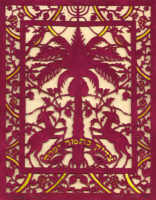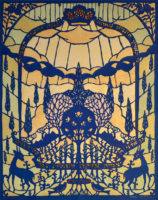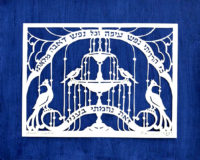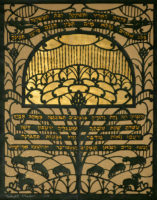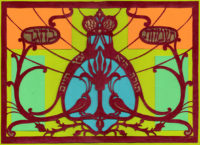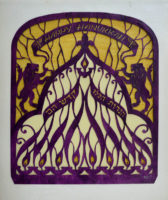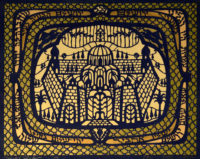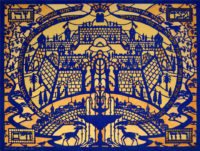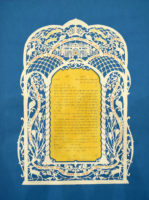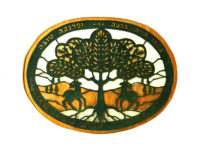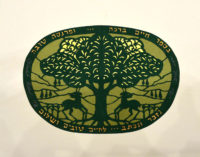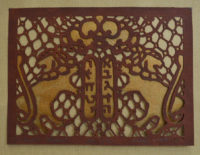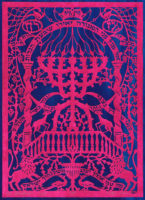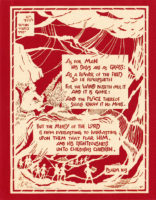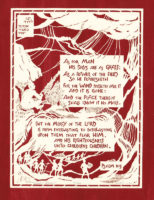Yehudit Shadur: Jewish Papercuts
This exhibit presents papercut art by Yehudit Shadur who draws on her traditional heritage of the Jewish folk art of devotional papercuts. Her vigorous compositions–a synthesis of venerable Jewish ritual themes and symbols and her own contemporary perceptions–are rendered in a universally appealing artistic language. Confined within a geometric framework, her elaborate motifs come to life and movement and are further enhanced by the coloring of underlays that add much splendor to her compositions.
Mizrah
Mizrah plaques are hung on the walls facing Jerusalem to indicate the direction of prayer. They often contain a variety of biblical and liturgical passages and many traditional symbols, some of which date to the very beginning of the Hebrew faith and identity over three millennia ago. Some typical symbols are
• Menorah – the seven-branched candelabrum, symbolizing the light of the Torah (Law)
• Crown – “keter torah”, the crown of Torah
• Columns – symbolic of the Holy Temple in Jerusalem
• Potted plant or tree – the Tree of Life
• Grapevine – symbol of the Hebrew people
• Lion and gazelle – “…fleet as the gazelle and brave as the lion to do the will of your Father in Heaven.” The gazelle is also another symbol for the people of Israel (“tzvi yisrael”) and the lion evokes majesty and sovereignty.
The inscriptions include:
• MIZRAH (east) – From this side the spirit of life
• The seven lamps shall give light against the candelabrum. (Numbers 8:2)
• “Kaftor va-ferach” (bud and flower) = extremely pleasing! (Exodus 25:23)
• How goodly are thy tents, O Jacob, Thy dwelling places, Israel! (Numbers 24:5)
• Depart from evil and do good. (Psalms 37:27)
• O how good it is for Israel, selah. (Psalms 73:1)
• Be strong as a leopard, swift as an eagle, fleet as a gazelle, and courageous as a lion to do the will of your Father in heaven. (Pirkei Avot – Ethics of the Fathers
19×17 in
11×8.5 in
17×13 in
10.25×8 in
10×14 in
27.5×39.25 in
Psalms and Prophets
Yehudit Shadur was fascinated with the flora and fauna of the land of Israel and its wild landscapes. The poetic imagery in the Books of Psalms and Prophets resonated with her and inspired her to create papercuts on the theme of “Rootedness in Land” and a rich variety of Jerusalem papercuts.
16×17 in
And a Little Child Shall Lead Them
10.5×13 in
8.25×6.5 in
8.5×6.5 in
16.5×15 in
15×12 in
15×11.75 in
5.5×7.25 in
6.75×8.5 in
9.5×8.75 in
Psalm 65 series
A song of thankfulness to God who hears prayers and forgives trespasses and makes miracles, who rules over the universe and brings blessings to the yields of the land.
Praise Awaits You, Our God, in Zion
17×13 in
Who Stilled the Roaring Sea
17×13 in
The Hills are Clothed With Gladness 17×13 in
The Job Series
Symmetry is abandoned in this five-panel series that tells the story of Job’s suffering and the anguished quest to understand God’s purpose. Shadur portrays Job in the stark, wild desert landscape of Edom and the Negev, incorporating verses from the Book of Job into the design of each episode.
There Once Was a Man in the Land of Utz
19.5×13.5 in
My Days Are Swifter Than a Weaver’s Shuttle
19.5×13.5 in
Then God Answered Out of the Whirlwind
19.5×13.5 in
Knowest Thou the Time?
19.5×13.5 in
Wherefore I Abhor My Words and Repent
19.5×13.5 in
Holidays
Among the smaller card-size papercuts are themes from Jewish Holidays, Psalms, Isaiah, Proverbs, and the Torah with inscriptions and blessings.
And you shall rejoice in your Festival
10×14 in
Torah is the Tree of LIfe
10×14 in
New Year Blessing
5.5×7.5 in
5.5×7.5 in
4.25×5.75 in
5.25×7.5 in
6×8 in
6.25×4.5 in
8.75×7.25 in
9×7.75 in
8.5×10.25 in
5.25×6.75 in
Jerusalem
Yehudit Shadur’s representation of Jerusalem draws on Jewish folk art forms in the Land of Israel in the 19th century that she had interpreted in her own way. Many of her mizrahs (“shining splendor” of the rising sun ) include the site of the Temple – the walled city of Jerusalem with its towers, palaces, gates, tall cypress trees and of course, the Holy Temple. This is the heavenly city of golden splendor – the ideal, “spiritual Jerusalem”. In time, the artist introduced elements of a more “earthly Jerusalem” in some of her compositions reflecting the real city of human habitation within and beyond the walls.
12.5×15 in
13×17.25 in
13.5×18 in
13.25×17 in
85×50 in
Ketubah
20×13.75 in
Miscellaneous
15.25×15 in
15.25×15 in
15.25×15 in
5.25×7.75 in
40×33 in
6×4.75 in
6.5×9.5 in
9.75×6 in
5×8 in
5.5×7 in
5.5×7.5 in
5×6.5 in
5.5×7 in
7.25×5.25 in
Laser Cut Works
10.5×7.5 in
10.5×7.5 in
10.5×7.5 in
10.5×7.5 in
10.5×7.5 in
10.5×7.5 in
11×8.5 in
10.5×7.5 in

